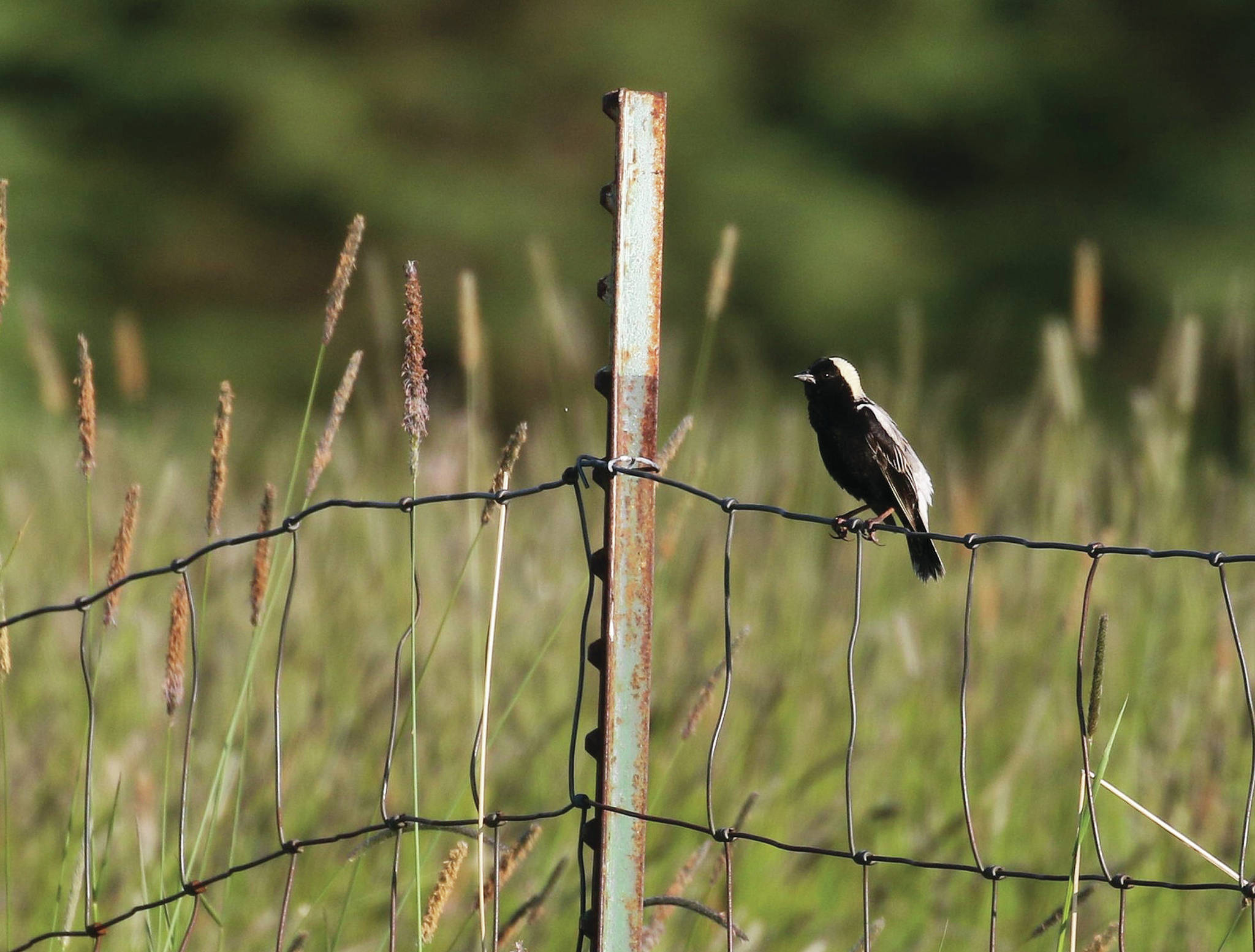June 23, 2019 started as almost every other day this summer. Hot, dry weather dominated from Hope to Seldovia. It was, however, unique in the birding world. Three visiting birders in Homer spotted a displaying adult male Bobolink singing at Seaside Farms in Homer, Alaska. It was well-photographed and recordings of the song were also collected.
The Bobolink is a stunning bird from the prairie region of the U.S. Males look like a blackbird that fell over backwards and landed in a bucket of yellowish white paint. The back of their head is dipped cream colored and most of their back is a grayish white, with the rest of their head and breast a glossy jet black.
This species spends the entire winter outside of the U.S., ranging to southern South America. Over the past several decades, ornithologists believe Bobolink numbers have been decreasing 1% to 1.5% per year. It is definitely one of the neotropical migratory birds people are concerned about in North America.
The occurrence of a new species of bird on the Kenai Peninsula is not always earth shattering. My go-to saying is “birds have wings and will travel.” We expect to eventually see some bird species. These birds may have occurred in other areas of the state, but are just not recorded on the Kenai yet. For these species, it is just a matter of time.
In other cases, we have no expectation of finding a particular species on the Kenai, but birds sometimes lose their way, only to become documented by a fortunate birder. In the last five years, 17 new species have been entered into eBird. The majority of these new records fit into the first category where there was a reasonable expectation that we would see them eventually on the Kenai if we just kept searching.
The Bobolink is what I would consider a hybrid of both types of new species sighting scenarios. It has been spotted in the state before, but all previous sightings in eBird were from southeast Alaska and spread out between 1991 and recent years. There was also a sighting from the Palmer area, but it never made it into eBird so the data is not readily accessible.
Nothing about the pattern of those previous sightings would make you think it would end up on the Kenai Peninsula. It also does not fit into the category of a one-time sighting with no expectations of ever seeing it again, since it had been seen elsewhere on multiple occasions.
Interestingly, the Bobolink’s occurrence in southcentral Alaska was actually predicted from climate suitability models that the Audubon Society copleted in 2017 for the Kenai National Wildlife Refuge. These scientists identified several grassland species that could become colonizers of the western Kenai Peninsula by the end of the century based on the current and predicted temperatures and other climate variables.
In 2019, Audubon released their latest interactive report on bird species vulnerability for over 600 species in North America (https://www.audubon.org/climate/survivalbydegrees). In this report you can actually control the variable of how fast the temperature is rising and even at the 1.5 degree Celsius level you begin to see a signature indicating colonization of Bobolink in southcentral Alaska north of the Kenai Peninsula.
Unfortunately for the Bobolink, their expansion to the north and west coincides with a slightly larger loss of suitable conditions along the southern extent of their known breeding range. If you select an even warmer scenario of three degrees Celsius, the model predicts a loss of 88% of the known breeding range, maintenance of 12% of the existing range, and a gain of 56% of newly colonized area by the end of this century. In all of these scenarios, there is still an overall net loss of nesting habitat for this species and this does not even consider changes on the wintering range.
There are several other surprising species on the list that have already been spotted on the Kenai Peninsula including Eastern Kingbird, Warbling Vireo and a 2019 discovery of a Red-eyed Vireo that was killed by a cat. I will not pretend that these individual sightings are a definitive measure validating any of these models. Nor would I profess that I believe all of the predictive outcomes of this model. I would consider them conversation pieces that raise questions about what the bird assemblages will look like if the climate continues to track on the current trajectory.
What I find truly alarming is the list of species that may find the climate and subsequent vegetation types unsuitable in the future on the Kenai Peninsula. Species like Rock and Willow Ptarmigan and Spruce Grouse are species that are loved by photographers, hunters, lynx, coyotes, large raptors and a host of other predators. What does our Kenai Peninsula look like if the models are even remotely accurate and we lose half or all of our ptarmigan or grouse?
Todd Eskelin is a Wildlife Biologist at Kenai National Wildlife Refuge. Find more Refuge Notebook articles (1999-present) at https://www.fws.gov/Refuge/Kenai/community/Refuge_notebook.html or other info at http://www.facebook.com/kenainationalwildliferefuge.

